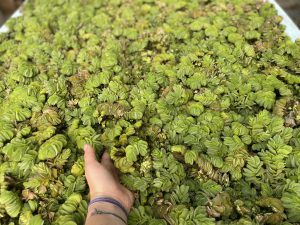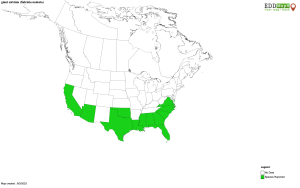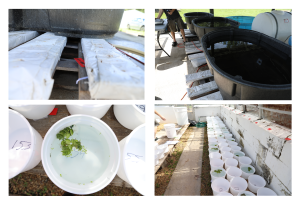This blog post was written by Corrina Vuillequez, Agronomy graduate student with UF/IFAS CAIP and aquatic plant control intern for the U.S. Army Corps of Engineers.
You might be wondering, “What if my boat has been out of the water for a week? Do I really still need to check it for giant salvinia before boating again?” Great question! Here at the UF/IFAS Center for Aquatic and Invasive Plants (CAIP), we have been wondering this as well. We are currently conducting a study to investigate how long giant salvinia can survive on boat bunks, and if the boat bunk material influences moisture retention.
What is giant salvinia?

Giant salvinia (Salvinia molesta), is a floating aquatic fern native to Brazil. It has a unique shape and interesting texture, making it attractive to ornamental gardeners around the world. Unfortunately, once introduced to the Southern United States it began to grow and take over lakes and ponds. This plant is known to double in less than 3 days! Not only does it grow outward, but it can also form thick, dense mats across the water’s surface. When giant salvinia starts invading an aquatic system, it outcompetes native plants both at the water’s surface and below. Its thick mats block sunlight from reaching submersed native plants, like eelgrass (Vallisneria americana), causing them to die off. This also decreases dissolved oxygen in the water column, resulting in negative impacts on fish and other aquatic fauna. Additionally, thick mats of giant salvinia impede boaters, fishermen, and swimmers from enjoying the water.
Where is it?

Giant salvinia has been reported in 13 states and is classified as a Federal Noxious Weed, meaning it is illegal to transport. It’s mainly been a problem in Texas and Louisiana, but it has recently been reported in Florida and other Southeastern states. However, since giant salvinia has not yet been established in Florida, we have the opportunity to help prevent its spread and keep our waters clear of this botanical menace.
How can boaters help?
Everyone who enjoys Florida’s lakes has an important role in maintaining the natural beauty and balance of the environment. One way boaters can help is by making sure they’re not bringing any invasive hitchhikers along for the ride between boating trips. When leaving a lake, take care to inspect the sides of the boat, the trailer, and the boat bunk itself for clinging plants, and hose them off as needed. When fishing, make sure to inspect any nets or equipment as well. This should also be done before entering a new lake. This process helps reduce the spread of giant salvinia and other invasives to new water bodies, so the native plants, animals, and people can continue to enjoy the lake!
Our Research

To do this, we set up three different “boats” on different bunks, pictured below. Each boat is actually a giant tub filled with water to add weight onto the bunk, simulating the pressure of a boat on a trailer. The bunks are made of planks covered in plastic, wood, or carpet. We place giant salvinia on top of the bunks, so they get crushed by the weight of the “boat”. We then remove and evaluate groups of salvinia at different time intervals. At these time intervals, we move giant salvinia from the bunk into “recovery tanks” to mimic them being released into a new lake. We then monitor their growth and survival over time.
This study is still ongoing, but we’ve seen interesting results so far. It looks like the plastic boat bunks slow water evaporation, and giant salvinia may be able to survive up to 8 days of being crushed by a boat on a plastic bunk! Carpet and wood can absorb moisture from the plants, drying them out faster. Plants may be able to survive up to four days of being crushed on these materials. These findings are just preliminary though, so stay tuned for updates as our results are analyzed. Overall, our study indicates that this plant is pretty durable and determined to survive transport to new water bodies.
What does this mean?
As enjoyers of Florida’s lakes, it’s especially important to be vigilant when traveling to new waters. Always check your boat for hitchhiking plants between trips. To be safe, it may also be necessary to let the boat sit out of water for a week or so after traveling to salvinia-infested waters to make sure there can be no surviving plants squished under your boat. The more we pay attention to this issue now, the less of a problem it’s likely to be in the future. With help from boaters like you, we can make sure Florida’s waters are beautiful and functional for years to come!
Visit our previous blog to learn how to Stop Those Plants! How to Prevent the Spread of Invasive, Aquatic Plants
Are you interested in more information on how to prevent the spread of harmful aquatic plants and other species? Visit Stop Aquatic Hitchhikers.
This blog post was written by Corrina Vuillequez, Agronomy graduate student with UF/IFAS CAIP and aquatic plant control intern for the U.S. Army Corps of Engineers. This post features research and information from a current project she is conducting at the Center. Questions or comments can be sent to the UF/IFAS CAIP communications manager at caip@ifas.ufl.edu. Follow UF/IFAS CAIP on Instagram, Facebook, and Twitter. Subscribe for more blogs like this one.
UF/IFAS Center for Aquatic and Invasive Plants. Turning Science Into Solutions.
Did you find this post helpful? Click the heart below!
 9
9
